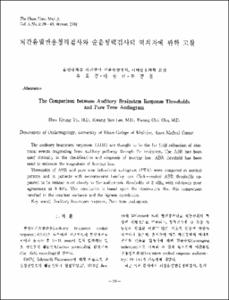한국인 Fragile-X 증후군 환자의 분자 유전학적 진단
- Alternative Title
- Molecular Diagnosis of Korean Patients with Fragile-X Syndrome
- Abstract
- Fragile-X syndrome (FXS) is the most common cause of inherited mental retardation. Until recently, the diagnosis of FXS has been made based on the cytogenetic expression of the fragile site at Xq27.3 (FRAXA) in the patients' cultured cells and on the results of linkage analysis with DNA markers surrounding the fragile X locus. The recent cloning of fragile-X gene(FMR-1) made it possible investigate the molecular defects in FMR-1 gene of individuals at risk. Vast majority of molecular defects of FXS has been known to be an abnormally amplified trinucleotide(cytosine guanine guanine) repeat.
This study aims at establishing the molecular genetic diagnosis of FXS as well as correlating genotype-phenotype analyzing the increment of amplified CGG repeat number, clinical findings, and cytogenetic expression rate in two Korean families with FXS patients. The FXS patients are tested cytogenetically & molecular genetically. The fragile site at Xq27.3 was cytogenetically expressed in folate deficient medium by culturing lymphocytes for 4 days. Molecular diagnostic approaches utilize the genomic DNA Southern blot analysis using genomic probe FXA 241 (ONCOR) and radiolabelled PCR-denaturing polyacrylamide gelelcetrophoresis.
Each patient expressed a FRAXA site in folate deficient medium with the expression rate of 38%, 16% respectively. The molecular genetic study showed that each patient had the CGG amplification 1.6kb, 0.7-0.8kb in the FMR-1 gene respectively. In addition, this study clarified the carrier status of each family members.
In conclusion, molecular genetic studies employed in this study can be utilized for a confimatory diagnostic purpose in FXS patients.
Fragile-X syndrome (FXS) is the most common cause of inherited mental retardation. Until recently, the diagnosis of FXS has been made based on the cytogenetic expression of the fragile site at Xq27.3 (FRAXA) in the patients' cultured cells and on the results of linkage analysis with DNA markers surrounding the fragile X locus. The recent cloning of fragile-X gene(FMR-1) made it possible investigate the molecular defects in FMR-1 gene of individuals at risk. Vast majority of molecular defects of FXS has been known to be an abnormally amplified trinucleotide(cytosine guanine guanine) repeat.
This study aims at establishing the molecular genetic diagnosis of FXS as well as correlating genotype-phenotype analyzing the increment of amplified CGG repeat number, clinical findings, and cytogenetic expression rate in two Korean families with FXS patients. The FXS patients are tested cytogenetically & molecular genetically. The fragile site at Xq27.3 was cytogenetically expressed in folate deficient medium by culturing lymphocytes for 4 days. Molecular diagnostic approaches utilize the genomic DNA Southern blot analysis using genomic probe FXA 241 (ONCOR) and radiolabelled PCR-denaturing polyacrylamide gelelcetrophoresis.
Each patient expressed a FRAXA site in folate deficient medium with the expression rate of 38%, 16% respectively. The molecular genetic study showed that each patient had the CGG amplification 1.6kb, 0.7-0.8kb in the FMR-1 gene respectively. In addition, this study clarified the carrier status of each family members.
In conclusion, molecular genetic studies employed in this study can be utilized for a confimatory diagnostic purpose in FXS patients.
- Issued Date
- 1994
- Type
- Research Laboratory
- Alternative Author(s)
- Kim,Kyung Mo; Yoo,Han-Wook
- Publisher
- 울산의대학술지
- Language
- kor
- Rights
- 울산대학교 저작물은 저작권에 의해 보호받습니다.
- Citation Volume
- 3
- Citation Number
- 2
- Citation Start Page
- 12
- Citation End Page
- 19
- Appears in Collections:
- Research Laboratory > The ULSAN university medical journal
- 파일 목록
-
-
Download
 000002024020.pdf
기타 데이터 / 344.03 kB / Adobe PDF
000002024020.pdf
기타 데이터 / 344.03 kB / Adobe PDF
-
Items in Repository are protected by copyright, with all rights reserved, unless otherwise indicated.